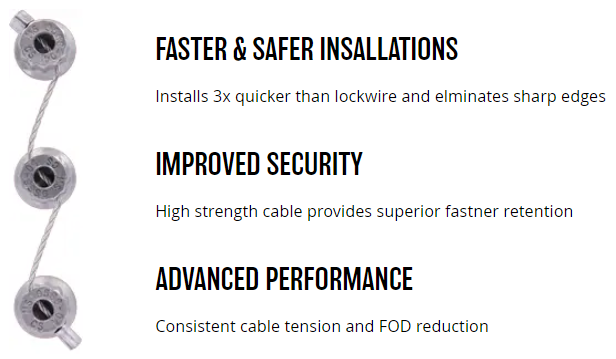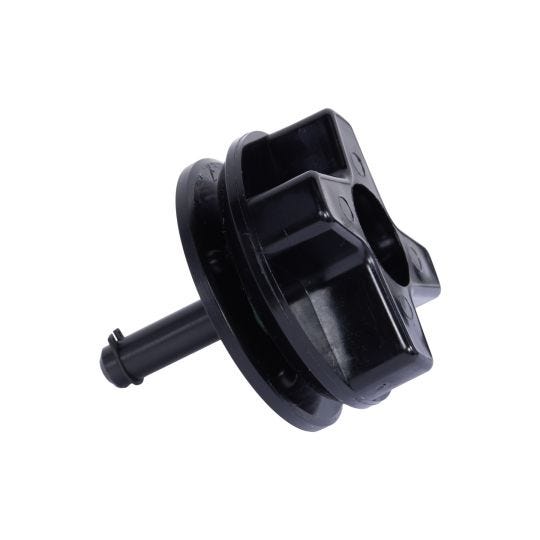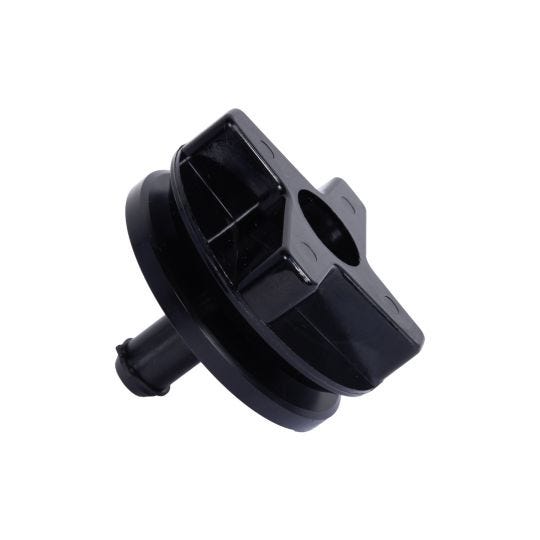Safe-T-Cable®
THE ULTIMATE FASTENER RETENTION SYSTEM
Safe-T-Cable™
Safe-T-Cable® is designed to prevent bolts, nuts, and other fasteners from loosening in environments with excessive heat and vibration. In addition to installing three times faster than lockwire, Safe-T-Cable also produces stronger and safer results. The user-friendly tooling guarantees a consistent installation with every use. Safe-T-Cable installations eliminate sharp edges, significantly reducing the risk of injury. It also minimizes repetitive motion injuries and Foreign Object Debris (FOD). Safe-T-Cable is easy to train, and rework is essentially eliminated. For best practices and resources click here.
Installing Safe-T-Cable® is Simple
First, thread the cable through the fasteners in a positive or neutral direction. Next, insert the free end of the cable through the ferrule and thread the cable through the nose of the tool. Then, use the tool to apply tension to the cable. Finally, crimp the ferrule, and cut the excess cable.


Benefits
FASTER & SAFER INSALLATIONS
Installs 3x quicker than lockwire and elminates sharp edges
IMPROVED SECURITY
High strength cable provides superior fastner retention
ADVANCED PERFORMANCE
Consistent cable tension and FOD reduction
THE RIGHT POWER FOR EVERY JOB
Adjustable and pre-set tension Safe-T-Cable® tools are available in manual, pneumatic, battery, and manual-hydraulic power types. Adjustable tension tools have a rotary tension mechanism that can be adjusted to your precise cable tension requirements. Pre-set tension tools are set at the factory and can be operated with a single hand. Multiple nose lengths accommodate most applications and are interchangeable between tools for the same cable size for added versatility.
Featured Product Categories
Global Leader
For 70 years, DMC Tools are global leaders, consistently produces the most trusted products for high-reliability applications. We are proudly Veteran own in the USA.
TEAM OF EXPERTS
Why trust someone other than a team built of experts in your field? DMC is built up of industry thought leaders, experts and engineers.
Custom Fit
DMC can design and manufacture custom tooling right here in the USA for all your machining, engineering, support needs. Learn More by contacting us
Industries We Serve
Placeholder (Waiting for Category Page)
Page Builder Page Elements View
Heading 1
Heading 2
Heading 3
Heading 4
Heading 5
Heading 6
BODY
Lorem ipsum dolor sit amet, consectetur adipisicing elit, sed do # incididunt ut labore et dolore magna aliqua. Ut enim ad minim veniam, quis nostrud exercitation ullamco laboris nisi ut aliquiconsequ at.Lorem ipsum dolor sit amet, consectetur adipisicing elit, sed do eiusmod tempor incididunt ut labore et dolore magna aliqua. Ut enim ad minim veniam, quis nostrud
LIST TEXT
- Lorem ipsum dolor sit amet
- Lorem ipsum dolor sit amet
- Two line ametLorem ipsum dolor sit ametorem ipsum dolor sit am
LIST TEXT
- Lorem ipsum dolor sit amet
- Lorem ipsum dolor sit amet
- Two line ametLorem ipsum dolor sit amet
ametLorem ipsum dolo
Commitment To Quality
At DMC our mission and vision guide us in providing the highest quality products and services. Our highly skilled team and organizational agility allow us to meet and exceed new and emerging needs of our clients. With more than 7 decades of experience manufacturing precision tooling for a variety of mission-critical applications, DMC has become synonymous with quality and integrity. From material procurement to machining and final inspection, DMC complies with national and international industry standards and requirements. Our certifications are proof of our unwavering promise to provide only the best.


FAR Compliance
FAR 52.204-25:Daniels Manufacturing Corporation does not and will not use/rely on/supply prohibited telecommunications and video surveillance services or equipment.
FAR 52.222-21: Daniels Manufacturing Corporation does not and will not maintain or provide segregated facilities for its employees.
FAR 52.222-25: Daniels Manufacturing Corporation has developed and has on file Affirmative Action Programs.
FAR 52.222-22 / FAR 52.222-26: Daniels Manufacturing Corporation has participated and has filed the necessary requirements subject to the Equal Opportunity Clause.
FAR 52.219-1:Daniels Manufacturing Corporation:
Is a small business concern
Is not a small disadvantaged concern
Is not a woman owned small business concern
Is a veteran owned small business concern
Is not a service-disabled veteran owned small business concern
Is not listed as a Hub-Zone small business concern.
FAR 52.209-5: Daniels Manufacturing Corporation is not presently debarred, suspended, proposed for debarment, or declared ineligible for award under Federal contracts.
FAR 52.222-50 Combating Trafficking in Persons: Daniels Manufacturing Corporation is compliant in accordance with this reference.
DFARS 252.225-7008 and 225.225-7009: Daniels Manufacturing Corporation is compliant in accordance with this reference.
FAR Compliance


GIDEP Safe-Alert
ASSOCIATIONS AFFILIATIONS
Daniels Manufacturing Corporation actively participates in the following industry associations. In doing so, we remain among the first to learn of new standards, trends, and developments. DMC also plays an integral role in providing training and subject matter expertise in ongoing dialogue. The following associations represent different segments of the industries we serve.


Army Aviation Association of America
The mission of the AAAA is to support the United States Army Aviation Soldier and Family. The AAAA was formed in 1957 by a small group of senior aviation officers in the active Army, the Reserve Forces of the U.S. Army and industry leaders. As an AAAA member, you will network in the Army Aviation Community through mentoring opportunities via AAAA Annual Summit, Symposia, and Chapter events. There are also programs for professional development from operations to training, including: doctrine, maintenance, acquisition and industry programs. Members can submit articles for publication in ARMY AVIATION, the official magazine for the AAAA. Members are also recognized for excellence by being submitted for, or nominating others for over 35 national awards like Soldier of the Year and Unit of the Year. The AAAA is sponsored by the Army Aviation Caucus of 56 Congressmen.


Aircraft Electronics Association


AEROSPACE INDUSTRIES ASSOCIATION
The Aerospace Industries Association (AIA), founded in 1919, only a few years after the birth of flight, is the premier trade association representing major aerospace and defense manufacturers and suppliers in the United States. Based in Arlington, Va., AIA is led by a Board of Governors that meets twice a year and consists of senior representatives of member companies at the c-suite level, and an Executive Committee that meets more frequently. A hallmark of AIA is that it receives its policy guidance from the direct involvement of CEO-level officers of the country’s major aerospace and defense companies. The government frequently seeks advice from AIA on issues, and AIA provides a forum for government and industry representatives to exchange views and resolve problems on non-competitive matters related to the aerospace and defense industry.


Helicopter Association International
For more than 60 years, HAI has provided support and services to its members and to the international helicopter community. Headquartered in Alexandria, Virginia, HAI members safely fly more than 5,000 helicopters some 2.3 million hours each year. The HAI is governed by a Board of Directors elected from the membership, with daily operations conducted by a dedicated professional staff. Since it was founded, the HAI has served its membership and taken many actions on behalf of helicopter operators throughout the world. The organization has benefited the entire industry, to include manufacturers, suppliers, operators, pilots and mechanics. The association’s initiatives have had a direct and positive impact on international helicopter activities.


